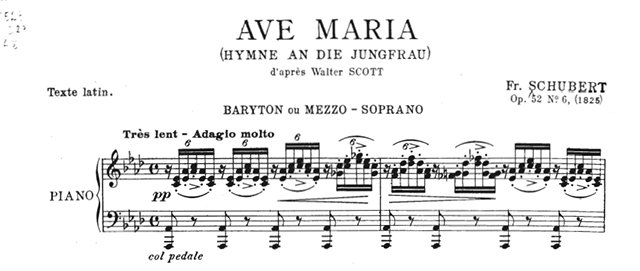
Marian Sheet Music
"The good hymn—one which endures and can be repeated without becoming tedious—is a significant part of our religious identity. It is sung prayer, a way of expressing our relation with God, Jesus Christ, the Virgin Mary, the saints. It is an effective form of teaching and presenting what we believe." – Fr. Thomas Thompson, S.M. ("The Popular Marian Hymn in Devotion and Liturgy," Marian Studies, vol. XLV, 1994) The Marian Library maintains a collection of over 700 pieces of Marian sheet music, including hymns, Mass settings, and even Christmas carols. The collection includes pieces for voice, piano, organ, even full orchestras, and includes songs in twelve languages dating from the sixteenth century to the present. Select public domain items from the collection have been digitized; additional pieces can be consulted by visiting the Marian Library. View the Guide to the Marian sheet music collection and the archival inventory. For more information contact the Marian Library at marianlibrary@udayton.edu.
-

The Cradle of Christ (Stabat Mater Speciosa): A Canticle for Christmas
Sir John Bridge, Jacopone da Todi, and John Neal
Arrangement for four-part chorus and piano of Sir John Frederick Bridge's "The Cradle of Christ." The lyrics are taken from a thirteenth century Latin hymn by Jacopone da Todi, translated in 1866 by Rev. Dr. John Mason Neale. The work was composed for the 1894 Hereford Musical Festival, and was dedicated to Rev. George Prothero, the Sub-dean of Westminster Abbey. This arrangement is for a four-part chorus of soprano, alto, tenor, and bass voice parts, with soprano and baritone solos.
-

The Rosary
Ethelbert Nevin and Robert Rogers
Arrangement for soprano or tenor soloist with mixed chorus (soprano, alto, tenor, and bass voice parts) and piano accompaniment of Ethelbert Nevin's popular hymn "The Rosary." The lyrics were written by Robert Cameron Rogers, and the song premiered in 1898. By 1928 it had sold over 2.6 million copies, making it one of the best selling pieces of sheet music of the period.
-

The Rosary (Le Chapelet, Der Rosenkranz)
Ethelbert Nevin, Robert Rogers, Theodore Baker, and Isadore Martinez
Arrangement for solo mezzo-soprano or baritone voice with piano accompaniment of Ethelbert Nevin's popular hymn "The Rosary," with French and German translations of the lyrics. The lyrics were written by Robert Cameron Rogers, with the French translation by Isadore Martinez and German translation by Theodore Baker. The song premiered in 1898. By 1928 it had sold over 2.6 million copies, making it one of the best selling pieces of sheet music of the period.
-

The Rosary (Le Rosaire, Der Rosenkranz)
Ethelbert Nevin, Robert Rogers, Carl Engel, and C. Eschig
Arrangement for solo mezzo-soprano or baritone voice with piano accompaniment of Ethelbert Nevin's popular hymn "The Rosary," with French and German translations of the lyrics. The lyrics were written by Robert Cameron Rogers, with the French translation by C. Eschig and German translation by Carl Engel. The song premiered in 1898. By 1928 it had sold over 2.6 million copies, making it one of the best selling pieces of sheet music of the period.
-

Totus Tuus Ego Sum
George Ennis and William Peffley
A hymn composed by George Ennis for the Legion of Mary, for solo voice with piano accompaniment and guitar tabs. This edition was translated into English by William Peffley.
-

Trisagi Marià
Joan Lambert
A Marian version of a Trisagion hymn. The work is broken into eight parts: "Pare Nostre," the first half of the Lord's Prayer (Our Father); "Deu Vos Salve," the first half of the Hail Mary prayer; "Gloria," the first half of the Glory Be prayer; "Santa," a prayer to Mary; "El Nostre Pa," the second half of the Lord's Prayer; "Santa Maria," the second half of the Hail Mary; "Sicut Erat," the second half of the Glory Be; and "Glòria a Maria," a final prayer to Mary. This sheet music is for two voices with an organ or harmonium accompaniment.
-

Trissagi a la Stma. Verge
Joan Lambert
A Marian version of a Trisagion hymn. The work is broken into eight parts: "Pare Nostre," the first half of the Lord's Prayer (Our Father); "Deu Vos Salve," the first half of the Hail Mary prayer; "Gloria," the first half of the Glory Be prayer; "Santa," a prayer to Mary; "El Nostre Pa," the second half of the Lord's Prayer; "Santa Maria," the second half of the Hail Mary; "Sicut Erat," the second half of the Glory Be; and "Glòria a Maria," a final prayer to Mary. This sheet music is for three voices with an organ or harmonium accompaniment.
-

Vier Marienlieder
Max Reger
A collection of four Marian hymns by Max Reger, arranged for two voice parts (soprano and alto or tenor and bass) with organ accompaniment. This work contains a conductor's copy with all voice and instrumental parts, and separate copies for the soprano/tenor and alto/bass voice parts without accompaniment.
-

Virgini Immaculatae
Ignaz Mitterer
Ignaz Mitterer's opus 122, a hymn in honor of the fiftieth anniversary of the papal bull Ineffabilis Deus, which defined the dogma of the Immaculate Conception of Mary. This song is written for a mixed chorus (soprano, alto, tenor, and bass voice parts), with orchestra (oboe, bassoon, French horn, trumpet, trombone, violin, viola, cello, and bass parts).
-

Wir Grüssen Dich Heute (To Mary Queen of the Angels)
Friedrich Koenen
A hymn for four voice parts (two sopranos and two altos) by Friedrich Koenen in honor of the Virgin Mary. This hymn appears to have been removed from an issue of The Caecilia: Magazine of Catholic Church and School Music from around the turn of the century.
-

Wunderschön Prächtige (Maiden of Thee We Sing)
Friedrich Koenen
A hymn for four voice parts (two sopranos and two altos) by Friedrich Koenen in honor of the Virgin Mary. This hymn appears to have been removed from an issue of The Caecilia: Magazine of Catholic Church and School Music from around the turn of the century.


